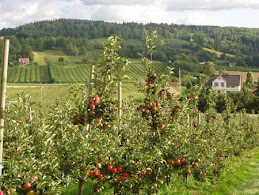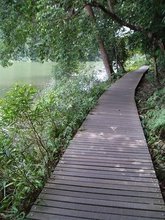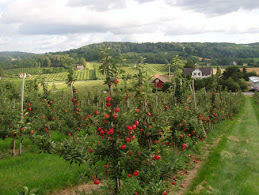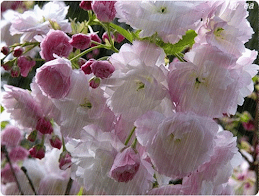MY PAPER TUESDAY AUGUST 24, 2010, HOME, PAGE A6
From http://myepaper.mypaper.sg/ebook/web_php/fvbrowserjs.php?urljs=http://myepaper.mypaper.sg/ecreator/sphopf/mya240810cnd_opf_files/mya240810cnd.js&ver=Gen
TEXT: GWENDOLYN NG, nggwen@sph.com.sg
DESIGN: EDMUND GOH
PHOTOS: NATIONAL PARKS BOARD, INTERNET
 PHOTO: GWENDOLYN NG, nggwen@sph.com.sg
PHOTO: GWENDOLYN NG, nggwen@sph.com.sg
MY PAPER TUESDAY AUGUST 24, 2010, HOME, PAGE A6
SINGAPORE is widely known as the Garden City, with about two million trees lining its streets and parks.
But they have hogged the headlines for the wrong reasons recently, after a number fell due to bad weather.
Still, National Parks Board (NParks) Streetscape Director Simon Longman assures the public that most of the trees which fell had been “healthy and well-grown”.
He identified the root of the problem as heavy rainfall, which causes large volumes of rainwater to accumulate in the ground. This in turn leads to the soil being saturated, which softens it, making it difficult for tree roots to stay anchored. This is why trees may get uprooted when a strong wind blows, Mr Longman added.
Last month, a rain tree fell on a car being driven by project manager Chua Loong Wai, 32, at the junction of Thomson Hills Drive and Yio Chu Kang Road, killing him.
While it may be difficult to predict such freak incidents, NParks said it is doing its best to ensure the public’s safety.
Between May and last month, NParks inspected an additional 3,200 trees on top of the usual 15,000 trees it inspects every month.
Mr Longman said: “NParks monitors the weather too. When we anticipate intense storm activity, we will carry out more inspections.”
In Parliament last month, National Development Minister Mah Bow Tan said in a written response that 240 trees and branches fell here in June, largely due to stormy weather.
Civil servant Liao Bi Qi, 23, said: “I know of someone who was injured when a branch snapped and fell on her in Orchard Road, so I try to avoid trees, especially when it’s raining.”
The recent spate of fallen trees has raised other questions among Singaporeans, especially on “instant” trees, which they perceive to have weaker root anchorage in bad weather.
This is because such trees are first grown in nurseries, and and are transplanted into soil along roads and in parks only when they are of an appropriate age. Said housewife Lin Pei Lian, 54: “Are those transplanted trees solid? They seem to be more susceptible to wind and rain.”
Mr Longman debunked their concerns, saying that they were an urban myth. He explained that such trees are put in bags to protect their roots during the transplanting process, and sticks are used to support them until they are firmly rooted in the ground.
Hardiness is taken into account when choosing a tree species to be planted in Singapore, he said. All 10 of the most commonly found trees (see infographics) in Singapore are hardwood ones. These 10 species also have buttress roots that provide extra stability, he pointed out.
While all are strong, Mr Longman noted that the sea almond tree is the toughest when it comes to withstanding bad weather.
One species, the softwood albizia tree, has branches which are likely to snap, and NParks has an ongoing programme to replace them with stronger varieties.
About 650 albizias have been removed here over the past three years. In 2007, an albizia tree fell on a 43-year-old woman, killing her at the Bukit Batok Nature Park. Investigations by NParks later revealed that the tree had been healthy.
NParks recorded about 1,000 cases of fallen trees last year, down from 3,100 cases in 2001.
The public can also do its part by alerting NParks to trees which look unhealthy or unstable.
Associate Professor Lu Xi Xi, from the National University of Singapore’s Department of Geography, believes that the key to preventing trees from falling lies in better soil management.
He said: “Disturbances, like construction and heavy traffic, have caused Singapore to have poor soil quality. The soil gets compacted, making it hard for a tree’s roots to penetrate deep into the soil.”
However, Mr Longman said that NParks uses “good-quality planting mixtures” for roadside trees, which encourages their root systems to develop and establish well.
He added that experts monitor the roots during their regular inspection rounds.
By GWENDOLYN NG, nggwen@sph.com.sg
HELPDESK
我的字典: Wǒ de zì diǎn
Uprooted: 连根拔起 - lián gēn bá qĭ
Nurseries: 苗圃 - miáo pǔ
Buttress: 支持 - zhī chí
Compacted: 压实 - yā shí
SOURCE: MY PAPER TUESDAY AUGUST 24, 2010, HOME, PAGE A6
TEXT: GWENDOLYN NG, nggwen@sph.com.sg
DESIGN: EDMUND GOH
PHOTOS: NATIONAL PARKS BOARD, INTERNET
TREES Trees have been in the headlines of late, and not always for a green cause. The 10 most common trees here were check out and experts clear the air on fact and fiction.
 PHOTO: TRUMPET TREE
PHOTO: TRUMPET TREE
MY PAPER TUESDAY AUGUST 24, 2010, HOME, PAGE A6
1. TRUMPET TREE
This tree’s name comes from its large trumpet-shaped flowers, which range in colour from pink to white. It is known for its impressive display of flowers, which can cover its whole crown. Flowering usually occurs in April and August, usually after a dry spell.
Take a look at them: Along North Buona Vista Road and Beach Road.
Origin: South America.
Height: 18m or more.
Fun facts: When the flowers fall, they retain their colour for a couple of days, forming a carpet of pink and white flowers. Tree accident reported in past two years:
June 2008 - A 20m-tall trumpet tree in Jalan Keria, Bukit Timah, fell and destroyed part of the garden of a one-storey house.
 PHOTO: Rain tree flowers
PHOTO: Rain tree flowers
MY PAPER TUESDAY AUGUST 24, 2010, HOME, PAGE A6
2. RAIN TREE
The majestic tree provides shade with its large umbrellashaped crown. When in bloom, clusters of pink-white flowers dot its canopy. It is the most commonly planted tree here with about 51,000 scattered across urban Singapore.
Take a look at them: Along East Coast Parkway.
Origin: A tropical American tree Height: Up to 25m.
Fun facts: Its leaves fold up just before the rain comes, which is how the tree got its name.
Tree accidents reported in last two years:
- July 2010 - A 30-year-old rain tree at the junction of Thomson Hills Drive and Yio Chu Kang Road, collapsed on a car and crushed 32-year-old project manager Chua Loong Wai.
- June 2010 - An 18m-tall rain tree toppled in front of the Istana because of rotten underground roots and an unbalanced crown.
 PHOTO: Sea apple flowers
PHOTO: Sea apple flowers
MY PAPER TUESDAY AUGUST 24, 2010, HOME, PAGE A6
3. SEA APPLE
This coastal tree has a crown made of large leathery leaves. Its white flowers are arranged in compact clusters with showy stamens. In Singapore, most sea-apple trees are in bloom from March to May.
Take a look at them: Along Grange Road and Evans Road.
Origin: Native tree.
Height: Up to 30m. Fun facts: As the tree does not burn easily, it was planted extensively to serve as a fire screen when Singapore had fields of flammable lalang grass.
Tree accident reported in last two years: July 2010 - A 15m-tall sea-apple tree fell on a car in Ang Mo Kio Street 22. The trio in the car escaped unscathed.
 PHOTO: Saga seed
PHOTO: Saga seed
MY PAPER TUESDAY AUGUST 24, 2010, HOME, PAGE A6
4. SAGA
This tree is well known for its bright red seeds, also known as love seeds. The tree’s large spreading crown makes it suitable for providing shade in gardens. As it is susceptible to damage in strong winds and has a tendency to grow untidy with age, it is no longer popularly planted along roads.
Take a look at them: Singapore Botanic Gardens.
Origins: India, and south-eastern China.
Height: Up to 20m.
Fun facts: Its characteristic scarlet seeds are uniform in weight – four of its seeds always weigh 1g.
 PHOTO: SEA ALMOND
PHOTO: SEA ALMOND
MY PAPER TUESDAY AUGUST 24, 2010, HOME, PAGE A6
5. SEA ALMOND
This coastal tree has a tiered, branching pattern, giving its crown a distinctive pagoda shape. Out of the 10 common trees here, NParks streetscape director Simon Longman identified it as the sturdiest, because of its exceptional ability to grow buttress roots.
Take a look at them: Along Changi Coast Road and in East Coast Park.
Origin: Native tree.
Height: Up to 25m. Fun facts: The tree’s leaves turn into vivid shades of red, yellow and orange as they wither.
 PHOTO: Angsana fruits
PHOTO: Angsana fruits
MY PAPER TUESDAY AUGUST 24, 2010, HOME, PAGE A6
6. ANGSANA
The tree has a recognisable drooping, domeshaped crown. Its fruits are disc-like flattened pods with papery wings.
Take a look at them: Along Orchard Road.
Origins: Malaysia, Philippines, Borneo.
Height: Up to 40m. Fun facts: Its wood has a rose-like scent and is used to manufacture fine furniture.
 PHOTO: Yellow flame tree in bloom
PHOTO: Yellow flame tree in bloom
MY PAPER TUESDAY AUGUST 24, 2010, HOME, PAGE A6 7. YELLOW FLAME
This ornamental tree is identified by the bright yellow blossoms on its crown.
Take a look at them: Along Orchard Road and in the Central Business District.
Origin: Native tree.
Height: 15m or more.
Fun facts: Its bark contains yellow-brown dye used in batik dying.
Tree accident reported in last two years:
July 2010 - Nicoll Highway was closed after a yellow flame fell and hit a taxi. No one was injured.
 PHOTO: Tembusu flowers
PHOTO: Tembusu flowers
MY PAPER TUESDAY AUGUST 24, 2010, HOME, PAGE A6
8.TEMBUSU
The native tree can live up to 200 years. When in bloom, its flowers give off a strong fragrance in the evening.
Take a look at them: At Dalvey Estate and along the Bukit Timah Expressway.
Origin: Native tree.
Height: Up to 40m. Fun facts: The tree is featured on the back of the $5 note.
 PHOTO: BROAD-LEAFED MAHOGANY
PHOTO: BROAD-LEAFED MAHOGANY
MY PAPER TUESDAY AUGUST 24, 2010, HOME, PAGE A6
9. BROAD-LEAFED MAHOGANY
The tree’s most distinctive features are its large, brown fruit pods, which split into five valves to release flat, winged, light-brown seeds.
Take a look at them: Along West Coast Road and Marine Parade Road.
Origins: South America and Mexico.
Height: More than 30m.
Fun facts: Regarded as the “original” mahogany in the furniture trade, it is used to make fine furniture and musical instruments.
 PHOTO: Fruits of Senegal mahogany
PHOTO: Fruits of Senegal mahogany
MY PAPER TUESDAY AUGUST 24, 2010, HOME, PAGE A6
10. SENEGAL MAHOGANY
This statuesque tree can be recognised by its clusters of small, white flowers and round fruit.
Take a look at them: Along Jalan Boon Lay and Eng Neo Avenue.
Origin: Tropical West Africa.
Height: More than 30m.
Fun facts: Used as furniture wood as it is highly valued for its beautiful grain and rich, reddish-brown colour.
Tree accident reported in last two years:
June 2010 - A senegal mahogany fell onto the Central Expressway, injuring two people.
Reference




















































.jpg)
.gif)
.jpg)

















































%20-%20%E5%82%B7%E5%BF%83%E7%9A%84%E8%B7%AF%20(Sh%C4%81ng%20x%C4%ABn%20de%20l%C3%B9)%20-%20The%20Road%20of%20Sorrow%20(With%20Subtitle)_11.png)






